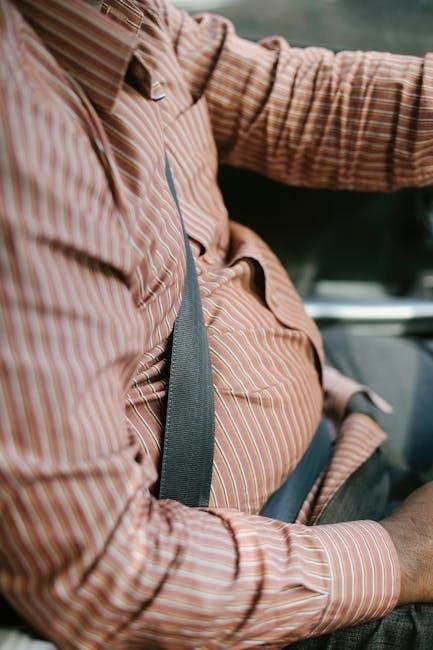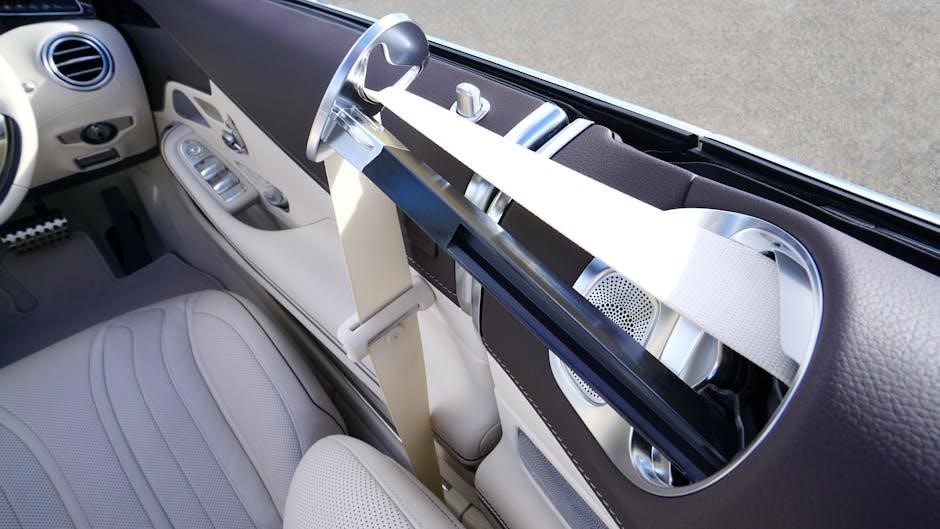Safety First Everfit All-in-One Car Seat: A Comprehensive Guide
This guide provides a comprehensive overview of the Safety First Everfit All-in-One car seat‚ designed for safety and convenience. We will explore its features‚ installation‚ maintenance‚ and troubleshooting. Our aim is to help parents confidently use this versatile car seat.
The Safety First Everfit All-in-One car seat is engineered to provide a safe and comfortable journey for your child‚ adapting through three distinct growth stages. This car seat accommodates children from infancy through their booster seat years‚ offering a versatile and cost-effective solution for parents. Understanding the features and proper usage of the Everfit is crucial for ensuring your child’s safety on the road.

This comprehensive guide aims to walk you through every aspect of the Everfit All-in-One‚ from initial installation to everyday maintenance. We’ll delve into the car seat’s key features‚ highlighting the benefits they offer for both child safety and parental convenience. Furthermore‚ we will explore the three stages of use‚ providing clarity on weight and height limits for each configuration.
A step-by-step installation guide will ensure that you can securely install the car seat in your vehicle‚ whether using the UAS belt or the vehicle’s seat belt. Harness and buckle adjustments will be discussed to guarantee optimal safety and comfort for your child as they grow. Cleaning and maintenance tips will help you keep the car seat in top condition. Finally‚ troubleshooting common issues and understanding the expiration date will provide you with the knowledge needed for long-term use.
Key Features and Benefits of the Everfit All-in-One
The Safety First Everfit All-in-One car seat boasts several key features designed to enhance safety‚ comfort‚ and convenience. One notable feature is its ability to adapt to three different stages of a child’s growth‚ accommodating weights from 5 pounds up to 65 pounds in harness mode‚ and beyond in booster mode. This versatility eliminates the need to purchase multiple car seats as your child grows.
Convenient harness holders keep the harness straps in an open position‚ simplifying the process of getting your child in and out of the car seat. This feature is particularly useful for busy parents who are often juggling multiple tasks.
Beyond convenience‚ the Everfit All-in-One prioritizes safety with features such as side impact protection and a five-point harness system. These features work together to provide superior protection in the event of a collision. The car seat is also designed for easy cleaning and maintenance‚ ensuring a hygienic environment for your child. Additionally‚ the car seat meets or exceeds all applicable federal safety standards‚ providing parents with peace of mind. The Everfit All-in-One offers a combination of safety‚ convenience‚ and longevity‚ making it a smart choice for families.
Understanding the Car Seat’s Three Stages
The Safety First Everfit All-in-One car seat is designed to adapt seamlessly to your child’s growth through three distinct stages‚ ensuring a safe and comfortable ride throughout their early years. Each stage caters to specific weight and height requirements‚ providing optimal protection and support.
Stage 1: Rear-Facing (typically from 5-40 pounds): In this initial stage‚ the car seat is positioned rear-facing‚ offering the best protection for infants and young toddlers. The rear-facing position minimizes stress on the child’s neck and spine in the event of a collision. It’s crucial to adhere to the car seat’s specific weight and height limits for rear-facing use.
Stage 2: Forward-Facing with Harness (typically from 22-65 pounds): As your child outgrows the rear-facing stage‚ the car seat can be converted to forward-facing mode with a five-point harness. This stage provides secure restraint for older toddlers and young children‚ distributing impact forces across the strongest parts of their body.
Stage 3: Belt-Positioning Booster (typically from 40-100 pounds): Once your child reaches the upper weight and height limits for the harness‚ the Everfit transitions into a belt-positioning booster. In this stage‚ the vehicle’s seat belt is used to secure the child‚ while the booster ensures proper belt placement for optimal safety.
Installation Guide: Step-by-Step Instructions

Proper installation of the Safety First Everfit All-in-One car seat is paramount to ensuring your child’s safety. Always consult both the car seat’s user manual and your vehicle’s owner’s manual for specific instructions and compatibility.

Step 1: Choose the Correct Mode: Based on your child’s weight and height‚ determine whether to install the car seat in rear-facing‚ forward-facing with harness‚ or booster mode.
Step 2: Prepare the Vehicle Seat: Ensure the vehicle seat is clean and free of any obstructions. Identify the lower anchors (LATCH) or seat belt path for installation.
Step 3: Install Using LATCH or Seat Belt: For LATCH installation‚ attach the car seat’s lower anchor connectors to the vehicle’s lower anchors. Tighten the connectors until the car seat is securely in place. If using the seat belt‚ thread the belt through the designated path on the car seat and buckle it. Lock the seat belt according to your vehicle’s instructions.
Step 4: Tighten and Secure: Regardless of the installation method‚ ensure the car seat is tightly secured. It should not move more than one inch side-to-side or front-to-back at the belt path.
Step 5: Check the Angle: Verify the car seat is at the correct angle using the built-in level indicator or angle adjuster. The angle will vary depending on the mode.
Harness and Buckle Adjustment for Optimal Safety
The harness and buckle system of the Safety First Everfit All-in-One car seat is crucial for your child’s safety. Proper adjustment ensures that your child is securely restrained in the event of a crash.
Harness Height: The harness straps should be positioned at or just below your child’s shoulders in rear-facing mode‚ and at or just above in forward-facing mode. Adjust the harness height by re-threading the straps through the appropriate slots.
Harness Tightness: The harness straps should be snug against your child’s body. You should be able to pinch no more than one inch of webbing at the shoulder. Tighten the harness by pulling the adjuster strap at the front of the seat.
Chest Clip Placement: The chest clip should be positioned at armpit level. This helps to keep the harness straps properly positioned on your child’s shoulders.
Buckle Adjustment: Ensure the buckle is securely fastened and that the straps are not twisted. The buckle should be positioned low on your child’s hips‚ not on their stomach.
Re-Checking Adjustments: Regularly check the harness and buckle adjustments as your child grows. Make sure the straps are always properly positioned and snug.
Refer to the Manual: Always consult the car seat’s user manual for detailed instructions and diagrams specific to your model.
Cleaning and Maintenance Tips
Maintaining the cleanliness of your Safety First Everfit All-in-One car seat is essential for hygiene and longevity. Regular cleaning prevents the buildup of dirt‚ spills‚ and crumbs‚ ensuring a comfortable and safe environment for your child.
Fabric Cleaning: Most Safety First car seat covers are machine washable. Refer to the car seat’s manual for specific instructions on removing and washing the cover. Use a mild detergent and a gentle cycle. Avoid using bleach or harsh chemicals.
Harness Straps: Clean harness straps with a damp cloth and mild soap. Do not submerge the straps in water or use harsh chemicals‚ as this can weaken the webbing. Allow the straps to air dry completely before reattaching them to the car seat.
Plastic Components: Wipe down the plastic components of the car seat with a damp cloth and mild soap. Ensure all soap residue is removed and the components are completely dry before use.
Buckle Cleaning: Clean the buckle with a damp cloth to remove any debris or buildup. Avoid using lubricants or solvents‚ as these can damage the buckle mechanism.
Regular Inspections: Periodically inspect the car seat for any signs of damage or wear. Check the straps‚ buckles‚ and plastic components for cracks‚ tears‚ or other issues.
Proper Storage: When not in use‚ store the car seat in a cool‚ dry place away from direct sunlight. This helps to prevent damage and prolong its lifespan.
FAA Compliance and Air Travel Information
When planning air travel with your child‚ understanding the FAA (Federal Aviation Administration) regulations regarding car seats is crucial. The Safety First Everfit All-in-One car seat is designed to meet or exceed all applicable federal safety standards‚ but it’s important to verify its FAA compliance before your trip.
FAA Approval: Look for a sticker on the car seat indicating FAA approval for use on aircraft. This sticker typically states‚ “This restraint is certified for use in motor vehicles and aircraft.” If the car seat has this label‚ it is approved for air travel.
Using the Car Seat on the Plane: While the FAA allows children to fly unrestrained on an adult’s lap‚ it is safest for your child to be secured in a car seat. Most airlines allow you to use an FAA-approved car seat for children who weigh under 40 pounds.
Airline Policies: Contact your airline in advance to confirm their specific policies regarding car seats. Some airlines may have restrictions on the size or type of car seat allowed.
Installation on the Plane: Install the car seat in a window seat to avoid blocking the aisle in case of an emergency. Follow the car seat’s installation instructions and use the aircraft’s seat belt to secure the car seat.
Travel Tips: Bring the car seat’s manual with you for easy reference. Arrive at the airport early to allow extra time for security checks and car seat installation.
Troubleshooting Common Issues
Even with careful installation and use‚ you might encounter some common issues with the Safety First Everfit All-in-One car seat. Here’s a guide to troubleshooting some frequent problems:

Harness Issues: If the harness is difficult to tighten or loosen‚ check for any obstructions or twists in the straps. Ensure the harness height is correctly adjusted for your child’s size. If the harness continues to stick‚ lubricate the mechanism with a silicone-based lubricant.
Buckle Problems: A stuck or difficult-to-unbuckle buckle can be frustrating. Ensure nothing is lodged in the buckle. Clean the buckle with warm water and a mild detergent. If the buckle remains problematic‚ contact Safety First customer support for a replacement.
Installation Difficulties: If you’re struggling to install the car seat securely‚ double-check the car seat’s manual and your vehicle’s owner’s manual. Ensure you’re using the correct installation method (LATCH or seat belt). If necessary‚ seek assistance from a certified Child Passenger Safety Technician (CPST).
Car Seat Movement: If the car seat moves excessively after installation‚ retighten the LATCH connectors or seat belt. Use a locking clip if the seat belt doesn’t lock properly. If the movement persists‚ try a different seating position in your vehicle.
Fabric Cleaning: For spills or stains‚ refer to the cleaning instructions in the manual. Use a damp cloth and mild soap. Avoid harsh chemicals or machine washing‚ as these can damage the fabric.
Understanding the Expiration Date
Car seats‚ including the Safety First Everfit All-in-One‚ have expiration dates. It is crucial to understand why these dates exist and how to locate them on your car seat. The expiration date isn’t arbitrary; it’s there for your child’s safety.
Why Expiration Dates Matter: Over time‚ the plastic components of a car seat can degrade due to temperature fluctuations‚ UV exposure‚ and general wear and tear. This degradation can compromise the structural integrity of the seat‚ making it less effective in a crash. Additionally‚ safety standards and technology improve‚ rendering older seats obsolete.
Locating the Expiration Date: The expiration date is typically found on a sticker on the car seat. Look for a label‚ often white‚ on the side or bottom of the seat. The label will clearly state the expiration date‚ sometimes expressed as “Do Not Use After” followed by a specific date. The date of manufacture may also be present.
What to Do After Expiration: Once the car seat has reached its expiration date‚ it should no longer be used. Safely dispose of the seat to prevent others from using it. Cut the harness straps and remove the fabric cover to discourage reuse. Check local recycling guidelines for car seat disposal options.
Safety Tips and Best Practices
To maximize your child’s safety with the Safety First Everfit All-in-One car seat‚ adhering to safety tips and best practices is paramount. These guidelines‚ combined with proper installation and usage‚ ensure optimal protection. Always prioritize your child’s well-being by following these recommendations.
Read the Manual: Thoroughly review the car seat’s user manual before installation and use. The manual provides crucial information about proper installation techniques‚ harness adjustments‚ and weight/height limits.
Proper Installation: Ensure the car seat is correctly installed in your vehicle‚ following either the LATCH system or the seat belt method. Double-check that the seat is secure and doesn’t move excessively.
Harness Adjustment: Adjust the harness straps to fit snugly against your child’s body. The straps should lie flat and not be twisted. The chest clip should be positioned at armpit level.
Rear-Facing as Long as Possible: Keep your child in a rear-facing position until they reach the maximum height or weight limit specified by the car seat manufacturer. This position offers superior protection in a crash.
Avoid Bulky Clothing: Dress your child in thin layers to ensure the harness fits properly. Bulky clothing can compress in a crash‚ leaving the harness too loose.
Accessing and Utilizing the User Manual
The user manual for the Safety First Everfit All-in-One car seat is your primary resource for safe and effective operation. Accessing and understanding this manual is crucial for proper installation‚ adjustment‚ and maintenance‚ ensuring your child’s safety during every ride. Treat it as a vital guide to responsible car seat usage.
Locating the Manual: The physical user manual typically comes packaged with the car seat. If you’ve misplaced it‚ don’t worry! A digital version can often be found on the Safety 1st website or by searching online using the car seat model number.
Understanding the Contents: The manual covers various topics‚ including installation instructions for different stages‚ harness adjustment guidelines‚ cleaning procedures‚ safety precautions‚ and troubleshooting tips. Familiarize yourself with each section.
Step-by-Step Installation: The manual provides detailed‚ step-by-step instructions for installing the car seat in rear-facing‚ forward-facing‚ and booster modes. Follow these instructions carefully to ensure a secure installation.
Harness and Buckle Adjustment: Learn how to properly adjust the harness straps and buckle to fit your child snugly and comfortably. The manual will guide you on achieving the correct fit for optimal safety.